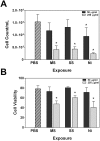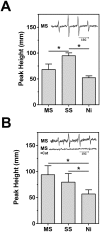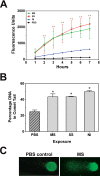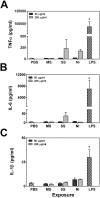A comparison of cytotoxicity and oxidative stress from welding fumes generated with a new nickel-, copper-based consumable versus mild and stainless steel-based welding in RAW 264.7 mouse macrophages
- PMID: 24977413
- PMCID: PMC4076336
- DOI: 10.1371/journal.pone.0101310
A comparison of cytotoxicity and oxidative stress from welding fumes generated with a new nickel-, copper-based consumable versus mild and stainless steel-based welding in RAW 264.7 mouse macrophages
Abstract
Welding processes that generate fumes containing toxic metals, such as hexavalent chromium (Cr(VI)), manganese (Mn), and nickel (Ni), have been implicated in lung injury, inflammation, and lung tumor promotion in animal models. While federal regulations have reduced permissible worker exposure limits to Cr(VI), this is not always practical considering that welders may work in confined spaces and exhaust ventilation may be ineffective. Thus, there has been a recent initiative to minimize the potentially hazardous components in welding materials by developing new consumables containing much less Cr(VI) and Mn. A new nickel (Ni) and copper (Cu)-based material (Ni-Cu WF) is being suggested as a safer alternative to stainless steel consumables; however, its adverse cellular effects have not been studied. This study compared the cytotoxic effects of the newly developed Ni-Cu WF with two well-characterized welding fumes, collected from gas metal arc welding using mild steel (GMA-MS) or stainless steel (GMA-SS) electrodes. RAW 264.7 mouse macrophages were exposed to the three welding fumes at two doses (50 µg/ml and 250 µg/ml) for up to 24 hours. Cell viability, reactive oxygen species (ROS) production, phagocytic function, and cytokine production were examined. The GMA-MS and GMA-SS samples were found to be more reactive in terms of ROS production compared to the Ni-Cu WF. However, the fumes from this new material were more cytotoxic, inducing cell death and mitochondrial dysfunction at a lower dose. Additionally, pre-treatment with Ni-Cu WF particles impaired the ability of cells to phagocytize E. coli, suggesting macrophage dysfunction. Thus, the toxic cellular responses to welding fumes are largely due to the metal composition. The results also suggest that reducing Cr(VI) and Mn in the generated fume by increasing the concentration of other metals (e.g., Ni, Cu) may not necessarily improve welder safety.
Conflict of interest statement
Figures







References
-
- Antonini JM, Lewis AB, Roberts JR, Whaley DA (2003) Pulmonary effects of welding fumes: Review of worker and experimental animal studies. Am J Ind Med 43: 350–360. - PubMed
-
- Hannu T, Piipari R, Kasurinen H, Keskinen H, Tuppurainen M, et al. (2005) Occupational asthma due to manual metal-arc welding of special stainless steels. Eur Respir J 26: 736–739. - PubMed
-
- Becker N (1999) Cancer mortality among arc welders exposed to fumes containing chromium and nickel. Results of a third follow-up: 1989–1995. J Occup Environ Med 41: 294–303. - PubMed
-
- Moulin JJ (1997) A meta-analysis of epidemiologic studies of lung cancer in welders. Scand J Work Environ Health 23: 104–113. - PubMed
Publication types
MeSH terms
Substances
Associated data
LinkOut - more resources
Full Text Sources
Other Literature Sources

